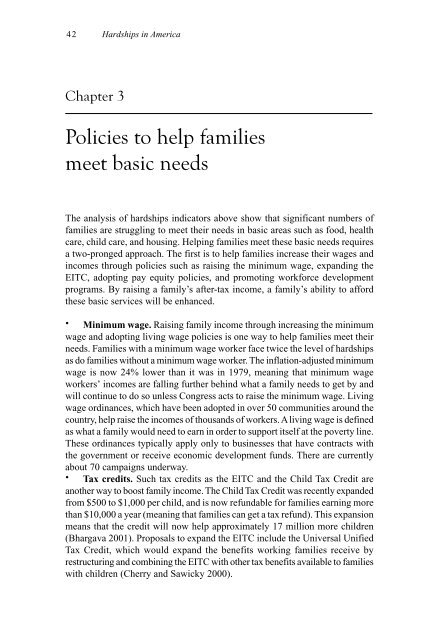You also want an ePaper? Increase the reach of your titles
YUMPU automatically turns print PDFs into web optimized ePapers that Google loves.
42 Hardships in America<br />
Chapter 3<br />
Policies to help families<br />
meet b<strong>as</strong>ic needs<br />
The analysis of hardships indicators above show that significant numbers of<br />
families are struggling to meet their needs in b<strong>as</strong>ic are<strong>as</strong> such <strong>as</strong> food, health<br />
care, child care, and housing. Helping families meet these b<strong>as</strong>ic needs requires<br />
a two-pronged approach. The first is to help families incre<strong>as</strong>e their wages and<br />
incomes through policies such <strong>as</strong> raising the minimum wage, expanding the<br />
EITC, adopting pay equity policies, and promoting workforce development<br />
programs. By raising a family’s after-tax income, a family’s ability to afford<br />
these b<strong>as</strong>ic services will be enhanced.<br />
· Minimum wage. Raising family income through incre<strong>as</strong>ing the minimum<br />
wage and adopting living wage policies is one way to help families meet their<br />
needs. Families with a minimum wage worker face twice the level of hardships<br />
<strong>as</strong> do families without a minimum wage worker. The inflation-adjusted minimum<br />
wage is now 24% lower than it w<strong>as</strong> in 1979, meaning that minimum wage<br />
workers’ incomes are falling further behind what a family needs to get by and<br />
will continue to do so unless Congress acts to raise the minimum wage. Living<br />
wage ordinances, which have been adopted in over 50 communities around the<br />
country, help raise the incomes of thousands of workers. A living wage is defined<br />
<strong>as</strong> what a family would need to earn in order to support itself at the poverty line.<br />
These ordinances typically apply only to businesses that have contracts with<br />
the government or receive economic development funds. There are currently<br />
about 70 campaigns underway.<br />
· Tax credits. Such tax credits <strong>as</strong> the EITC and the Child Tax Credit are<br />
another way to boost family income. The Child Tax Credit w<strong>as</strong> recently expanded<br />
from $500 to $1,000 per child, and is now refundable for families earning more<br />
than $10,000 a year (meaning that families can get a tax refund). This expansion<br />
means that the credit will now help approximately 17 million more children<br />
(Bhargava 2001). Proposals to expand the EITC include the Universal Unified<br />
Tax Credit, which would expand the benefits working families receive by<br />
restructuring and combining the EITC with other tax benefits available to families<br />
with children (Cherry and Sawicky 2000).



